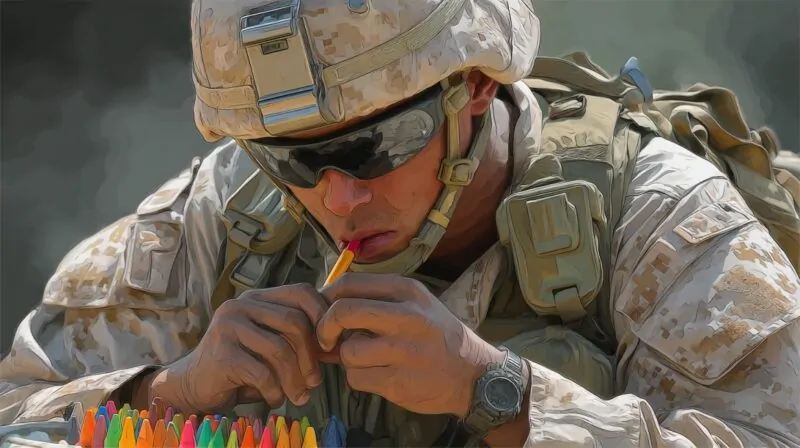Dog tags are small, durable identification plates worn by soldiers to ensure their personal information can be recovered in the event of injury or death.
Each tag typically bears a service member’s name, identification number, blood type, and religious preference.
These tags serve a vital role in ensuring proper medical treatment and respectful burial procedures.
Identification in military contexts has always been critical, as history shows how easily chaos and loss can blur the identities of those who served.
Dog tags represent more than mere pieces of metal; they symbolize accountability, honor, and the value of every individual who wears a uniform.
Their use spans over a century and remains an integral part of military identity worldwide today.
Table of Contents
ToggleWhat Is the Origin of Dog Tags?
Origins of modern dog tags can be traced to the American Civil War between 1861 and 1865.
Soldiers faced the harsh truth that death on the battlefield might also mean permanent anonymity.
Many feared being buried without identification, leaving families without closure.
In the absence of an official system, they created their own improvised solutions to ensure their names would be known if they fell.
- Writing personal details on scraps of paper or cloth and tucking them into uniforms
- Stenciling or sewing names onto jackets or bags
- Engraving initials on coins, metal discs, or small wooden tags
Such makeshift approaches highlighted how deeply soldiers valued personal recognition, even in death.
Records show that over 40% of Union soldiers who died during the war were never identified, a figure that underscored the urgency of establishing a standardized method of identification.
John Kennedy, a civilian entrepreneur, proposed manufacturing engraved ID tags in bulk for the Union Army, but his offer was declined.
Despite official inaction, soldiers continued to find ways to mark themselves before going into battle.
Historical notes, including those from the Juniata Council, describe how troops would pin handwritten cards or small tags to their coats prior to combat.
This grassroots approach marked the beginning of a long evolution that would eventually lead to the dog tags known today.
Why the Nickname “Dog Tags”?

The term “dog tags” carries an interesting and debated history. Several theories attempt to explain how the nickname entered military slang.
One widely accepted version credits newspaper magnate William Randolph Hearst.
In 1936, he reportedly mocked the government’s introduction of Social Security identification cards by comparing them to dog tags.
Soldiers and civilians quickly adopted the term, and it stuck.
World War II draftees embraced the phrase as a form of humor and rebellion. Many joked that they were being treated like dogs, cataloged and tagged by the government.
The resemblance to pet identification tags only reinforced the association. Civilian society mirrored this symbolism, as pet ID tags became increasingly popular during the same era.
Today, this association has become a meaningful expression of remembrance, often visualized through personalized designs made using a card generator.
- Satirical origin tied to Hearst’s Social Security commentary
- Soldier slang comparing military tagging to pet registration
- Visual similarity to civilian dog ID tags
Over time, “dog tags” evolved from a mocking term to one of pride and respect. They now represent courage, service, and remembrance, an emblem of every soldier’s identity and sacrifice.
Push for Official Recognition
@rememberww2 99 year old WW2 veteran shows off his dog tags that he wore in battle! Please help me interview more WWII veterans by going to www.GoFundMe.com/rememberww2 #fyp #wwii #history #veterans #army #soldiers ♬ Beautiful film music ambient orchestra – Tansa
By the late 19th century, military leaders began addressing the absence of a uniform identification system.
Chaplain Charles C. Pierce emerged as a leading advocate in 1899 after witnessing the confusion and loss that occurred during the Spanish-American War.
He formally proposed standardized identity discs for soldiers, arguing that proper identification was a matter of respect and recordkeeping.
In 1906, the U.S. Army officially adopted the first aluminum identification disc.
- Soldier’s full name
- Rank
- Company designation
- Regiment assignment
This simple yet revolutionary measure ensured every service member carried a lasting identifier. By 1916, a second tag was introduced—one stayed with the body while the other was collected for documentation.
When regulations in 1917 made dog tags mandatory for all combat troops, the practice shifted from personal initiative to official policy.
Soldiers marched into battle not only with weapons and courage but also with their identities permanently engraved in metal, symbolizing both duty and individuality.
Design Evolution and Standardization
@claim_the_past Replying to @JacksonM115 #wwii #ww2 #ww2history #history #archeology #war #military #worldwars #dogtags #soldiers #usmilitary #discovery #familyhistory #genealogy ♬ Hide (Slow) – Dorian Concept
Dog tag design continued evolving during World War I. The U.S. Army used lightweight aluminum discs, while the Navy preferred Monel, a more durable and corrosion-resistant metal.
- Aluminum tags for Army soldiers
- Monel metal tags for Navy personnel
- Etched fingerprints on Navy tags for added security
- Introduction of religious identifiers (C for Catholic, H for Hebrew, P for Protestant)
The interwar period and World War II brought additional refinements.
The 1940 model, known as the M1940, introduced the familiar “notched” design and expanded the information included on each tag.
- Full name and serial number
- Blood type
- Tetanus immunization date (such as “T42” for 1942)
- Religious affiliation
- Next-of-kin contact
Branches of the military each maintained slight differences in format, but by the early 1940s, bead chains replaced the earlier flat-link designs.
Two tags were standard issue, one on a long chain and the other on a short chain, to allow easy separation for record purposes.
By 1943, the system had been well-refined, with its functionality, durability, and consistency defining modern military identification standards.
Modernization and Changes Post-WWII

Postwar developments brought modernization and consolidation across all military branches.
During the 1950s and 1960s, the U.S. military established a standardized dog tag format that would endure for decades.
- Removal of tetanus shot dates, no longer deemed necessary
- Replacement of serial numbers with Social Security Numbers between 1959 and 1965
- Uniform formatting across the Army, Navy, Air Force, and Marine Corps
The Vietnam era revived the practice of separating the two tags upon a soldier’s death, symbolizing respect and documentation.
For the Marine Corps, additional data was sometimes included, such as gas mask size, a reflection of the practical needs in chemical warfare.
The modernization of dog tags didn’t stop with analog systems. In 2015, concerns over identity theft led to one of the most significant updates in decades.
Social Security Numbers were removed and replaced with Department of Defense Identification Numbers to enhance personal security in the digital era.
Modern dog tags continue to serve both functional and symbolic purposes. They ensure accurate identification while representing a soldier’s personal story, sacrifice, and connection to service.
Summary
Dog tags endure as a timeless military tradition blending practical necessity with emotional depth.
Over the decades, their evolution has mirrored technological progress, changing battlefield needs, and shifting attitudes toward personal recognition.
Today, dog tags serve as personal emblems of duty, legacy, and humanity, reminding every soldier that even in the chaos of conflict, their name and story will never be forgotten.
Related Posts:
- Top 10 Military Dog Breeds That Serve on the Front Lines
- 7 Reasons Why Soldiers Engage in Risk-Taking Behavior
- 10 Common Scams Targeting Veterans - And How to Avoid Them
- Navy Seals vs. Marine - What Sets Them Apart?
- BMW Military Discount for Active Duty Soldiers and Veterans
- Are Soldiers Spending Too Much Time on After Action Reports?







